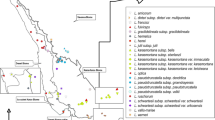Abstract.
Fifty natural Datura populations, belonging to eleven species (D. ceratocaula, D. discolor, D. inoxia, D. kymatocarpa, D. lanosa, D. metel, D. pruinosa, D. quercifolia, D. reburra, D. stramonium, D. wrightii) from Mexico and adjacent USA, were investigated using starch gel electrophoresis. A total of 64 alleles were scored at 17 loci (DIA1, DIA2, GOT1, GOT2, G6PDH, IDH, MDH1, MDH2, MDH3, ME, PGD1, PGD2, PGM1, PGM2, PHI, SAD, SOD). The heterozygosity among the species ranged from 0.166 (D. ceratocaula) to 0.276 (D. wrightii). Most genetic diversity was found within populations (average Hs=0.242), while values between populations are relatively low (average Dst=0.066, Gst=0.171). The analysis of the genetic distance suggested new taxonomic relationships among the species. Rather than supporting the conventional infrageneric classification with three sections, the results revealed that the herbaceous members of the genus Datura form four groups. One group included four of the eight species of the section Dutra and was more similar to the section Ceratocaulis than it was to the other group that contained the remaining taxa of Dutra.
Similar content being viewed by others
Author information
Authors and Affiliations
Additional information
Received February 13, 2001 Accepted December 25, 2001
Rights and permissions
About this article
Cite this article
Jiao, M., Luna-Cavazos, M. & Bye, R. Allozyme variation in Mexican species and classification of Datura (Solanaceae). Plant Syst. Evol. 232, 155–166 (2002). https://doi.org/10.1007/s006060200039
Issue Date:
DOI: https://doi.org/10.1007/s006060200039



